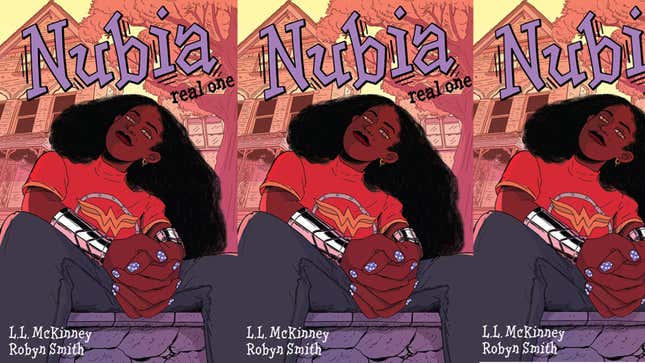
Black women are the most looked over, underappreciated, and undervalued people in this country. This is as true in life as it is in storytelling. Fortunately, DC Comics has made concerted efforts in recent years to address this lack of representation, and with Nubia: Real One, writer L.L McKinney and artist Robyn Smith have delivered a powerful, heartfelt, and authentic portrayal of a Black girl trying to be a hero in a world that refuses to see her as one.
Nubia: Real One is a graphic novel from DC’s young adult line, and it focuses on Nubia during her teenage years. Nubia has always known she was different since she was a toddler. Anytime her Amazonian power displayed itself, her mothers Amera and Danielle would have to pack up and move with the help of a mysterious guardian known only as D. The book introduces us to Nubia as a teenager who is navigating the social and emotional complexities of high school alongside her friends Quisha and Jason.
At the start of the book, her biggest concern is simply not embarrassing herself around her crush, Oscar. An attempt to spit game at Oscar in a convenience store goes south when two robbers hold up the place. In a moment of panic, Nubia displays her powers in true comic book fashion by chucking an ATM at them. What would be the de-facto origin story for a white superhero ends with Nubia in the back of a cop car because the clerk automatically assumed she had something to do with the robbery.
With that moment, the book quickly establishes that this isn’t going to play out like your traditional origin story.
One of the greatest strengths of the book is how rooted in reality it feels. The book bleeds authenticity off of every page, no doubt bolstered by the fact that this is a book helmed by two Black women. It fully accounts for the moment we’re in, with one of the major plot points being the trio of Nubia, Quisha and Jason going to a protest after an unarmed boy in their neighborhood was shot and killed by police.
I mean straight up, white fragility is the primary threat of the book. Whether it’s the asshole white kid at school who thinks he’s owed Quisha’s affections and Nubia’s respect, or the people throughout Nubia’s life who can’t see a powerful Black girl without automatically assuming she’s a threat.
High school is hard enough, but when you add superpowers and a world that refuses to see a Black woman as a hero, it makes sense that for a large chunk of the book Nubia is questioning her worth and feeling like a mistake.
I’d be remiss if I didn’t mention the gorgeous, expressive art by Robyn Smith. The best comics are a perfect marriage between artist and material, and Nubia: Real One is no exception. The art perfectly drives home the emotional turmoil Nubia experiences throughout the book, as well as perfectly capturing her in all her heroic glory.
Ultimately, the message of the book is a powerful one. The world doesn’t get to determine your worth; you do. That’s a message I think all Black kids, boys or girls, need to hear. It’s hard not to relate to Nubia, to see yourself in her struggles, and I find that to be the greatest strength of the book.
I truly hope this is only the start of our adventures with Nubia because she’s a real one in a world that needs them now more than ever.
Nubia: Real One is in stores now.



